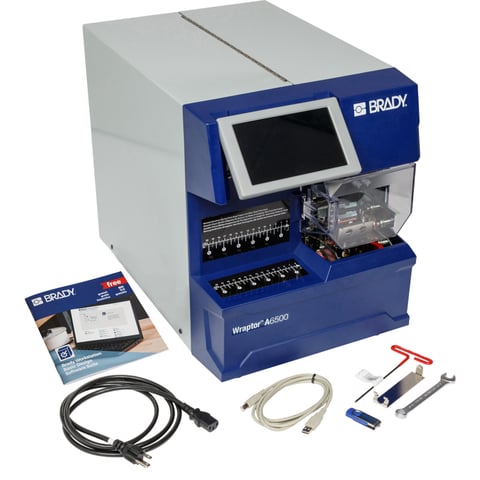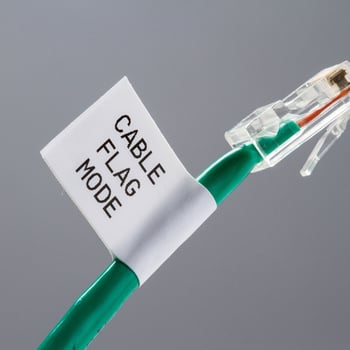 Industrial labels might be small, but they can have a huge impact on your workplace or application. An effective and consistent labeling and signage system offers several key benefits:
Industrial labels might be small, but they can have a huge impact on your workplace or application. An effective and consistent labeling and signage system offers several key benefits:
- Increased productivity
- Improved profitability
- Easier-to-use equipment
- Safer & more secure
Those benefits are easy enough to understand, but at first glance the seemingly endless types and brands are not. Which wire marking solution makes sense for your users? Keep reading for tips on selecting the best wire and cable labels based on environmental, safety, compliance, application, and material considerations.
Types of Cable/Wire Labeling Systems
While there are many wire identification options out there, industrial electrical cable and wire markers fit into three main types:
- Heat-shrink sleeves
- Wrap-arounds
- Flags & tags
They have some of the same positive qualities, yet also differ in ideal application, use before vs. after termination, and other factors.
Heat-Shrink Cable Sleeves
These are what you’ll most often find on wires and cables in electrical control panels. Heat-shrink wire labels are durable and easy to use.
Heat-shrink sleeves slide over the cable before termination, eliminating them as an option for some projects. The user moves them along a wire until they shrink into position, creating a snug label. The sleeve position is still adjustable after terminating the cables, but not after you apply heat.
Heat shrink sleeves come in a ladder-style carrier or as a continuous roll. Wire diameter sizes go up to 7/8" for heat-shrink wire markers, but the most readily available sizes are:
Wire gauges for shrink tube sleeves run up to 0000-1 AWG, but the easiest-to-find sizes are:
- 16-22
- 10-20
- 8-12
- 6-18
- 2-8
- 0-5
Wrap-Around Cable Markers
This style of wire marker, which includes the well-known category of self-laminating cable labels, is the answer when you have terminated wires and can't get sleeves over them.
These labels are adhesive and wrap around the diameter of a wire. Available in preprinted and stand-alone forms, the material is typically clear polyester or vinyl, with a small, white area for marking by hand or printer.
Variations of the wrap-around label offer a twist on these benefits.
- Self-laminating – Includes a clear tail that laminates the legend, protecting it from contaminants and moisture
- Repositionable – Easy and clean moving and removing, yet sticky as you need it to be
- Rotating – For open and closed connections. They spin freely around the cable, allowing a worker to read them from any angle
 Cable Flags & Tags
Cable Flags & Tags
Cable and wire marking flags literally stick out as an easy-to-see reminder of important data. Their top benefit is having the space to fit several lines of information (and maybe even a barcode).
On the downside, they're less durable than wrap-around labels.
Consider P- or T-shaped flag markers when you want to limit contact between wires and labels, but still need plenty of labeling space. Flags and tags are a wise way to mark wires and cables that are already attached.
Tags are common in applications with large single and bundled cables, conduits, and hoses. They're a non-adhesive option made of tear-resistant polyethylene, typically attached via ties made of nylon or stainless steel.
Sizes are typically 2.5" to 3" wide. In height, the most popular options are:
Buying the Best Cable/Wire Labels: What to Watch For
Because most industrial equipment has high capital cost and strict upkeep, consider every detail of your product and application before choosing a labeling system:
- Durability
- Materials
- Cable/wire size
- Marker location
- Other application-specific factors
Durability
Depending on the application, effective industrial labeling can require a boatload of durability traits:
- Abrasion resistance
- Self-extinguishing & anti-flammability
- Fuel & oil resistance
- Low- & high-temperature resistance
- Solvent & chemical resistance
- Outdoor weather
- Ultra-aggressive adhesion
It's a bad use of time and money to mark a wire in a way that won't last. It's even worse if your poorly marked networking system injures a user or passer-by.
Example your applications for signs you need more durable industrial labels:
- How long will the marking (ideally) be in place?
- Is the application built to meet certain standards or requirements?
- Will the wire labels be exposed to fire/explosion, oil, water, dirt, wind, or chemical hazards?
Think about the environment of the cabling -- not just in its storage area, but also any new location someone might move it. An electronics distributor with expertise in cable and wire labeling can help you match your environment to the right markers.

Materials
Industrial wire and cable labels come in a wide range of materials engineered for reliable identification. Here are some of the most common materials' uses and benefits:
Material
|
Benefit
|
Uses
|
| Paper |
Low-cost |
Warehouse, shipping, work-in-process |
| Polyester |
Resistant to water & other harsh conditions; easier to read in low lighting |
Component ID, barcoding, asset & inventory tracking |
| Metallized polyester |
Name-plate quality |
Serial & rating plate |
| Raised panel polyester |
Aggressive adhesive & solvent resistance; name-plate quality |
Push button, internal connection points, rating & serial plates; replacing engraved tags |
Polyimide
(synthetic resin) |
Excellent mechanical, thermal, & chemical properties; can be sterilized without damage |
Circuit boards & electronic component identification in high-risk industries |
Nylon
(polyamides) |
Tear-resistant |
Wires being pulled through long conduits or framing posts |
Polyolefin
(polypropylene, polyethylene) |
Stays legible when wet; excellent resistance to chemicals/solvents & heat |
General ID, laboratory, medical, biological & food environments |
| Vinyl |
Excellent oil and dirt resistance; works well on curved and rough surfaces. |
General purpose & outdoors |
Gauge Size
A cable/wire marker is always more reliable when you pair it properly to the wire's size. This ensures it's readable and well-attached.
Think of the wire gauge's impact on a self-laminating marker, whose sleeve needs enough diameter to wrap around the substrate and fit nicely after heating. You can narrow your selection quickly by following these rules of thumb:
- Sleeves: At least 2x the height of the cable's diameter
- Self-laminating: +/- 6.5x the cable's diameter
- Other wrap-arounds: +/- 3.5x the cable's diameter
- Thick wires: Use straps and a bundle tag
We used wrap-around labels as the example because they tend to excel with a wide range of cable sizes. If you're leaning toward wrap-around, self-laminating options, use a Self-Laminating Label Size Calculator to quickly figure out the dimensions you need. Or, if you have the wires' sizes on hand, you can easily sort out the proper label size with a formula:
- Wire diameter x pi (about 3.14) = wire circumference
- Wire circumference x 1.5 = label height
Using this sizing method, you can wrap the label 1.5 times around the wire.
Marker Location
Marker location plays a big role in choosing a system, with termination being the major supporting -ation.
You probably already noticed that marking the wire before or after termination is important, but what does that actually mean to label choice?
- Sleeves -- only usable before termination
- Wrap-arounds -- usable before or after termination
- Flags & tags -- usable before or after termination
Other Application-Specific Factors
There are several factors in buying industrial labels that are hinted at above, but deserve their own callout. These are especially important in applications that demand high reliability and accountability:
- Readability – How critical is it that your marker remains legible in its end-use location? Sometimes color coding is enough; other times the cable needs a specific code or number and would be easier to make with a preprinted label or marking printer.
- Compliance – Your industry may require you to follow UL969 standards for labels when selling to U.S. buyers. Check for other geography-based regulations to ensure your product isn't missing a requirement.
- Label size -- How much information do you need to fit on the label? Make sure all important data can fit on the label without using tiny font or handwriting.
- Bundling -- If you’ll have a lot of networking bundles with high need for traceability, consider print-on hook materials. These make it easy to install, reposition, and uninstall labels so you don't waste time and money with new labels.
Where to Find the Best Cable Labels
By using a standardized, well-organized cable identification system, you can reduce the time you spend troubleshooting, installing, and repairing industrial equipment. But pretty much any label vendor promises improved safety and efficiency, so how do you find the label solution for you?
Because the best wire and cable labeling system is adaptable to your specific needs, rely on suppliers and distributors with a track record of understanding industrial project work. They'll understand how to label wires, whether in a control panel, structural build, or another use.
We have a long history distributing labeling products, from Brady wire markers to dozens of other leading sources. Preview our manufacturer list to assess your buying options:



 Industrial labels might be small, but they can have a
Industrial labels might be small, but they can have a  Cable Flags & Tags
Cable Flags & Tags

No Comments Yet
Let us know what you think